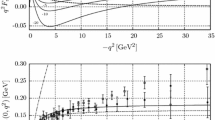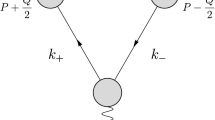Summary
An extension of the Veneziano model to PS-V elastic scattering is presented, in which the mother Regge trajectory of each family considered has definite parity (both possibilities are considered: natural and unnatural parity dominance). The formulae obtained are then discussed from different points of view: factorization is not trivially satisfied in general, even for mother trajectories; the Adler self-consistency conditions are not automatically fulfilled, but one can impose them by relating the natural and unnatural parity contributions; as to superconvergence and finite-energy sum rules, they give rise to some difficulties, which, although not specific of the spin case, are increased in this situation.
Riassunto
Si presenta un'estensione del modello di Veneziano allo scattering elastico PS-V, in cui la traiettoria di Regge madre di ogni famiglia considerata ha parità definita (si considerano entrambe le possibilità della dominanza della parità naturale e non). Si discutono da differenti punti di vista le formule ottenute: in generale la fattorizzazione non è soddisfatta banalmente, neanche per le traiettorie madri; le condizioni di autocoerenza di Adler non sono soddisfatte automaticamente, ma si possono imporre collegando i contributi della parità non naturale e naturale; per quanto concerne la superconvergenza e le regole di somma di energia finita, esse danno origine ad alcune difficoltà, che, sebbene non specifiche per lo spin, aumentano in questa situazione.
Резюме
Предлагается обобщение модели Венециано для случая упругого рассеяния PS-V, в которой материнская траектория Редже для каждого рассмотренного семейства имеет определенную четность (рассматриваются обе возможности: естественное и неестественное преобладание четности). Затем полученные формулы обсуждаются с различных точек зрения: факторизация, вообще говоря, не удовлетворяется тривиально, даже для материнских траекторий; условия самосогласованности Адлера не быполняются автоматически, но можно предположить их, посредством связывания вкладов естественной и неестественной четности; что касается сверходимости и правил сумм при конечной щнергии, то они приводят к возникновению некоторых трудностей, которые, хотя и не являются специфическими для спинового случая, но увеличиваются в зтой ситуации.
Similar content being viewed by others
Footenotes
G. Veneziano:Nuovo Cimento,57 A, 190 (1968).
P. G. O. Freund andE. Schonberg:Phys. Lett.,38 B, 600 (1969);G. Costa:Lett. Nuovo Cimento,14, 665 (1969);M. Jacob:Duality in strong-interaction Physics, CERN preprint (1969);A. Capella, B. Diu, J. M. Kaplan andD. Schiff:Lett. Nuovo Cimento,13, 655 (1969). The last paper will be quoted as I in what follows.
The unnatural-parity contribution to πρ→πρ has also been treated byM. Jacob (2) andE. S. Abers andV. L. Teplitz:Phys. Rev. Lett.,22, 909 (1969).
M. Gell-Mann, M. Goldberger, F. Low, A. Marx andF. Zachariasen:Phys. Rev.,133, B 145 (1964).
Notice that, for a givenJ, only one out of the four independent amplitudes has NP.
Notice that formulae (2.8) contain three arbitrary parameters. In I we proposed a different way of satisfying conditions (2.3) and (2.7), which led to a one-parameter solution. Since there are 4 independent helicity amplitudes, one might think that the generalization of the Veneziano formula should have 4 constants, in which case one should add extra terms to (2.8).
The correct behaviours of the invariant amplitudes for fixedt ands→∞ being already ensured in (2.8), we have only added terms ins α(t)-2 inA 2,A 3 andA 4. One could adopt a different point of view: for instance, if all trajectories have the same slope, one can imagine to fulfil conditions (2.3) by imposing a relation between NP and UP terms which individually behave ass α(t).
We assume here that exotic resonances do not exist, which will imply exchange degeneracy for theI=0 andI=1 trajectories. This is not compulsory: ifI=2 resonances were found, one could easily accomodate them.
C. Lovelace:Phys. Lett.,28 B, 269 (1968).
The factor Г(α+1/2)/Г(α), common to all three reactions, has been included in the definition of the β′s.
A general discussion on this point can be found inA. Capella, A. P. Contogouris andJ. Tran Thanh Van:Phys. Rev.,175, 1892 (1968); andNucl. Phys. (to be published).
The first daughter with unnatural parity starts to contribute to terms int α-3.
M. Ademollo, S. Weinberg andG. Veneziano:Phys. Rev. Lett.,22, 83 (1969).
One could think that in the πρ case, since one deals with the π-A1 trajectory, this condition could be satisfied\(\left( {\alpha _\pi \left( {m_\rho ^2 } \right) \simeq \tfrac{1}{2}} \right).\) However, formulae (2.9) show that it is not.
In I the whole NP contribution toA 1 verified ASCC, and thus β1 should be equal to zero, unless one adds higher terms.
More precisely, it is always possible to choose\(\mathop S\limits^ - \) in the l.h.s. of (4.6) in such a way that agreement is also obtained for the next-to-leading term. However, for this value of\(\mathop S\limits^ - \), the third term in the expansion is not the one expected.
Notice that the l.h.s. of eq. (4.8) corresponds to a right-signature sum rule and therefore the wrong-signature fixed poles which are known to be present inB(s, u) (18) do not appear in (4.8).
V. Alessandrini andD. Amati:Phys. Lett.,29 B, 193 (1969).
Author information
Authors and Affiliations
Additional information
In partial fulfilment of the requirements for the degree of Docteur-ès-Sciences Physiques. Faculté des Sciences d'Orsay, Université de Paris, 1969.
Laboratoire Associé au CNRS.
Traduzione a cura della Redazione.
Перевебено ребакцией.
Rights and permissions
About this article
Cite this article
Capella, A., Diu, B., Kaplan, J.M. et al. Pseudoscalar-vector meson scattering in the veneziano model. Nuovo Cimento A (1965-1970) 64, 361–381 (1969). https://doi.org/10.1007/BF02754899
Received:
Published:
Issue Date:
DOI: https://doi.org/10.1007/BF02754899




